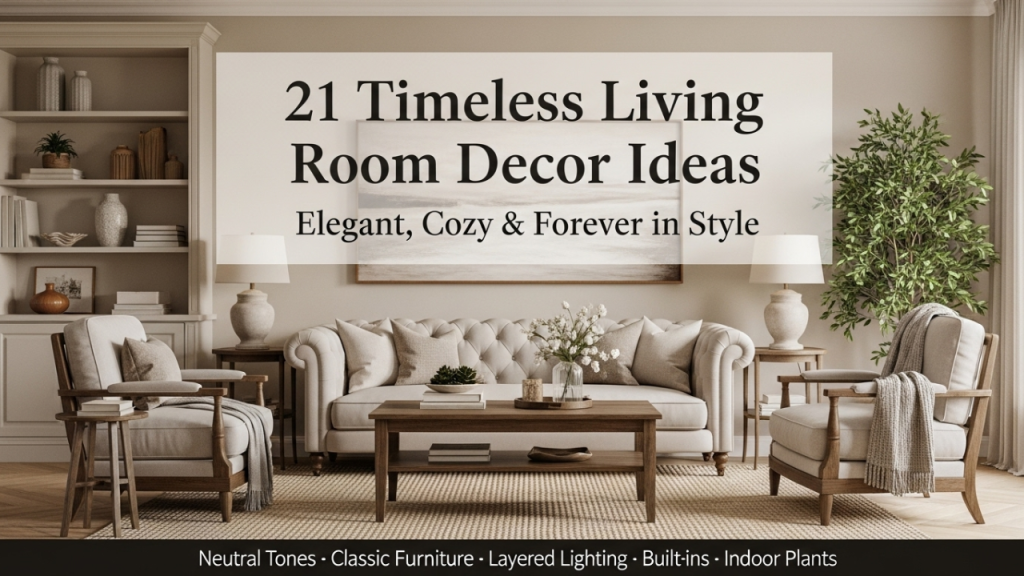Trends may come and go, but some living room decor ideas stand the test of time.
These classic elements not only look great year after year but also bring warmth, balance, and sophistication to your space.
Whether you’re designing from scratch or giving your living room a refresh, here are 21 timeless decor ideas to inspire you — and tips on how to get them right.

Table of Contents
1. Neutral Color Palette
Description: Soft whites, beige, greys, and taupes never go out of fashion. They create a calm and versatile backdrop.
Why it works: Neutrals make the room feel open, serene, and spacious.
How to do it:
- Start with a neutral base for walls and larger furniture.
- Layer different shades (e.g., warm cream with soft grey) for depth.
What not to do:
- Don’t let it get boring—use texture (linen, jute, wood) to avoid a flat look.
2. Classic Wood Elements
Description: Whether it’s hardwood floors, furniture, or decor accents—wood adds warmth and character.
Why it works: Wood brings natural texture and timeless appeal.
How to do it:
- Opt for quality wood coffee tables, bookshelves, or beams.
- Mix finishes (e.g., walnut + oak) in moderation.
What not to do:
- Avoid cheap wood laminates—they age poorly.
3. Statement Artwork
Description: A large, striking painting or photograph becomes a visual anchor.
Why it works: Art adds personality and sophistication without being trendy.
How to do it:
- Choose pieces that resonate with you emotionally or culturally.
- Hang at eye level for best impact.
What not to do:
- Don’t over-clutter the wall—let one piece stand out.
4. Layered Lighting
Description: Use a combination of ambient, task, and accent lighting for a cozy, flexible vibe.
Why it works: Layered lighting adapts to mood and function.
How to do it:
- Include floor lamps, table lamps, and sconces.
- Use warm LED bulbs (2700K–3000K).
What not to do:
- Avoid only using overhead lights—it can make the room feel harsh.
5. Built-In Bookshelves
Description: Built-ins offer function and a refined architectural touch.
Why it works: They showcase personality and give structure to the room.
How to do it:
- Organize by color, height, or category.
- Mix books with decorative items (vases, frames, etc.).
What not to do:
- Don’t overcrowd—leave breathing space on each shelf.
6. Tufted Sofas or Armchairs
Description: Chesterfield or button-tufted styles have an old-world charm that endures.
Why it works: Tufted pieces feel plush and timelessly elegant.
How to do it:
- Choose durable fabrics like linen or velvet.
- Pair with minimalist decor for balance.
What not to do:
- Avoid matching every seating piece in the same tufted style.
7. Natural Fiber Rugs
Description: Jute, sisal, and wool rugs are classics that ground the space beautifully.
Why it works: They add texture and an earthy element.
How to do it:
- Use them as base layers under smaller rugs.
- Choose sizes that anchor furniture (under front legs at least).
What not to do:
- Avoid overly small rugs—they make rooms feel disjointed.
8. Fresh Greenery or Indoor Plants
Description: A simple indoor plant or two instantly enlivens the space.
Why it works: Plants bring in life, color, and air-purifying benefits.
How to do it:
- Choose low-maintenance types like snake plants or pothos.
- Use ceramic or terracotta planters for a classic touch.
What not to do:
- Don’t overdo it; a jungle look is trendy, not timeless.
9. Black and White Accents
Description: This high-contrast combo adds visual clarity and elegance.
Why it works: It’s bold, versatile, and forever stylish.
How to do it:
- Try black frames, white walls, or monochrome pillows.
- Balance with softer elements (wood, textiles).
What not to do:
- Avoid stark all-black or all-white looks—they can feel cold.
10. Mix of Old and New
Description: Combining vintage finds with modern pieces gives character and charm.
Why it works: It prevents your space from feeling like a showroom.
How to do it:
- Use antique mirrors, heirloom tables, or thrifted art.
- Blend with contemporary seating or lighting.
What not to do:
- Don’t let mismatched items compete—keep color tones consistent.
11. Cozy Throw Blankets and Pillows
Description: Soft accessories make the room feel inviting.
Why it works: These items are functional, seasonal, and easy to refresh.
How to do it:
- Layer different textures (knit, faux fur, velvet).
- Stick to a cohesive color scheme.
What not to do:
- Don’t pile on too many—three to five pillows are enough.
12. Wall Molding or Wainscoting
Description: Architectural details like panel molding elevate the room.
Why it works: Adds depth and visual interest.
How to do it:
- Paint molding the same color as the walls for subtle elegance.
- Use thin, symmetrical patterns.
What not to do:
- Don’t go overly ornate unless your home’s architecture matches.
13. Gallery Walls with Personal Touches
Description: Curate a wall with art, photos, and mementos that tell your story.
Why it works: It brings warmth and uniqueness.
How to do it:
- Use consistent frames or a tight color scheme.
- Layout on the floor first to plan balance.
What not to do:
- Avoid making it look like clutter—edit ruthlessly.
14. Classic Curtains
Description: Floor-length, neutral or patterned curtains bring softness and height.
Why it works: They make windows a feature and soften acoustics.
How to do it:
- Hang high and wide to make ceilings look taller.
- Choose natural fabrics like linen or cotton.
What not to do:
- Avoid short curtains—they make rooms feel smaller.
15. A Centerpiece Coffee Table
Description: A solid wood or marble coffee table grounds the room visually.
Why it works: It becomes a gathering focal point.
How to do it:
- Style with a tray, books, and a small plant.
- Choose a sturdy material that ages well.
What not to do:
- Don’t over-clutter with too many small items.
16. Symmetry in Layout
Description: Arranging furniture and decor symmetrically creates balance and calm.
Why it works: Symmetry is pleasing to the eye and gives structure.
How to do it:
- Pair armchairs, lamps, or artwork evenly on either side of a focal point.
- Use rugs or wall decor to anchor symmetry.
What not to do:
- Avoid overly rigid layouts—add some visual breaks with accessories.
17. Timeless Decorative Trays
Description: A tray adds structure and polish to consoles or tables.
Why it works: Keeps items contained and stylish.
How to do it:
- Use for candles, vases, coasters, or remotes.
- Stick with metal, wood, or marble finishes.
What not to do:
- Avoid overloading the tray—curate a few statement items.
18. Classic Mirrors
Description: A beautiful mirror adds light, space, and elegance.
Why it works: Mirrors bounce light and visually expand the room.
How to do it:
- Place across from windows or light sources.
- Choose timeless shapes like ovals or antique frames.
What not to do:
- Don’t use too many mirrors—they lose impact.
19. Timeless Accent Chairs
Description: A well-chosen accent chair adds personality and function.
Why it works: It breaks up sofa-heavy rooms and offers flexible seating.
How to do it:
- Try a leather club chair, mid-century armchair, or classic wingback.
- Choose neutral upholstery or subdued patterns.
What not to do:
- Avoid trendy, bold colors if aiming for timelessness.
Also Read: 21 Small-Space Boho Home Decor Ideas For You
20. Functional Yet Stylish Storage
Description: Storage that looks good—like baskets, ottomans, or built-ins—is essential.
Why it works: Helps reduce clutter while maintaining aesthetics.
How to do it:
- Use woven baskets, lidded boxes, or stylish cabinets.
- Match finishes to the room palette.
What not to do:
- Avoid plastic bins or visible clutter.
21. Personal Touches
Description: Ultimately, your space should reflect you.
Why it works: Personal items add soul and uniqueness.
How to do it:
- Display souvenirs, handmade pieces, or family heirlooms.
- Incorporate your favorite books, colors, or scents.
What not to do:
- Don’t follow trends blindly—timelessness comes from authenticity.
Final Thoughts
A timeless living room isn’t about expensive pieces or strict rules—it’s about creating a space that feels welcoming, balanced, and personal.
Use these ideas as a guide, but make sure your personality shines through. Because the most timeless thing of all is a home that feels like you.









